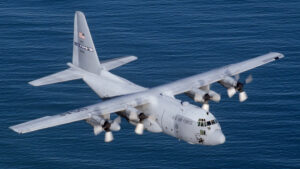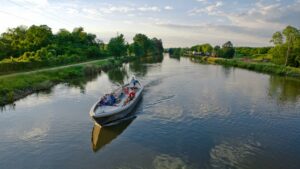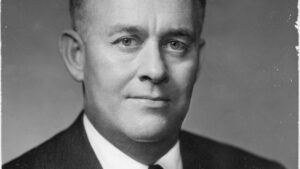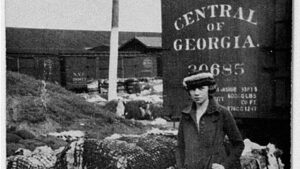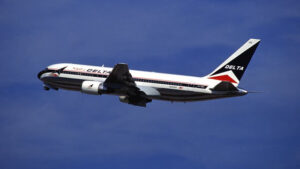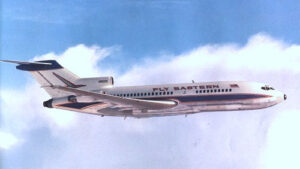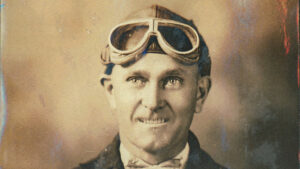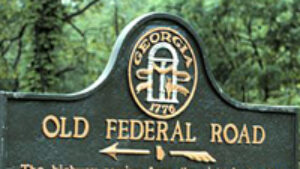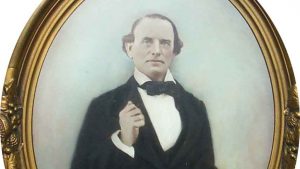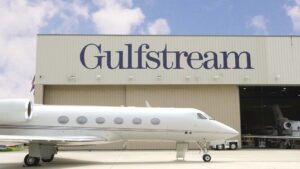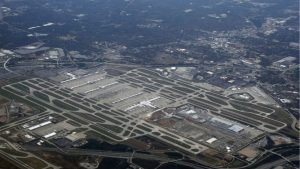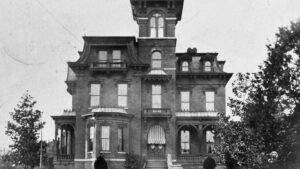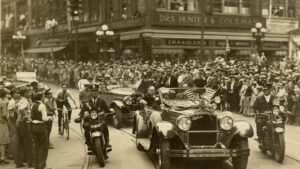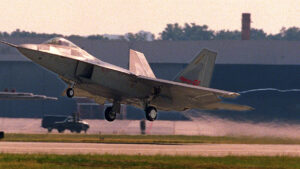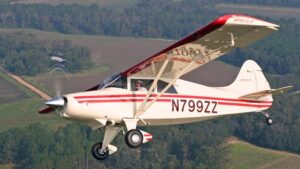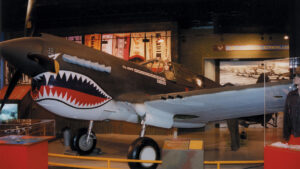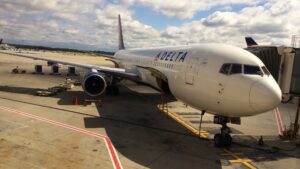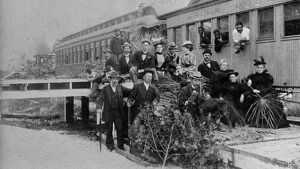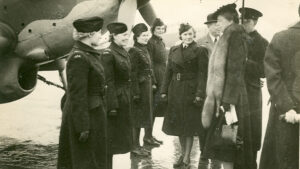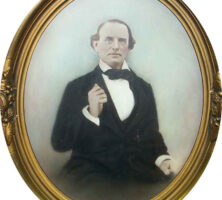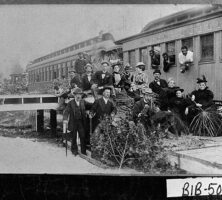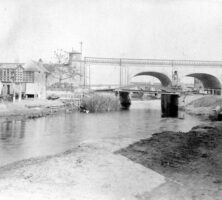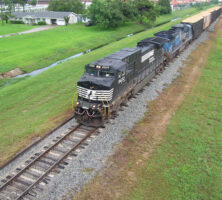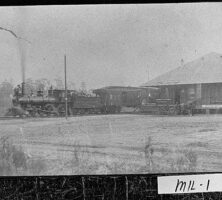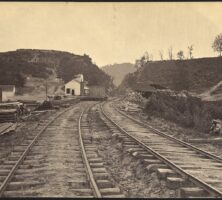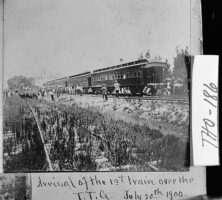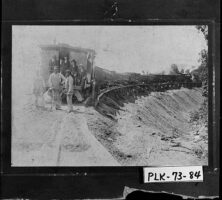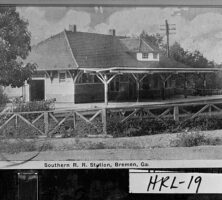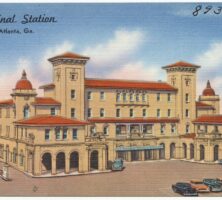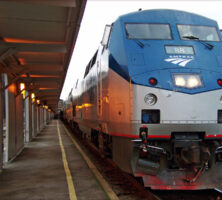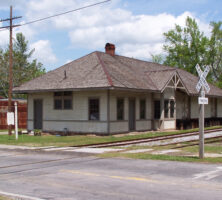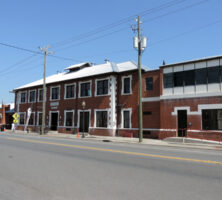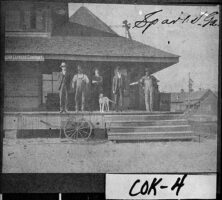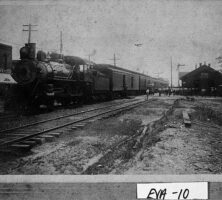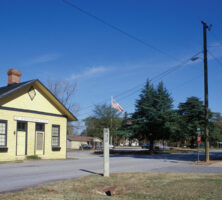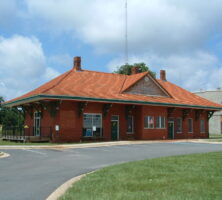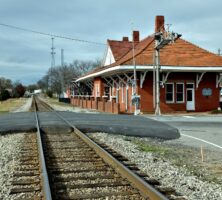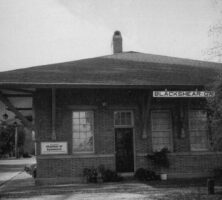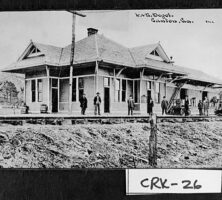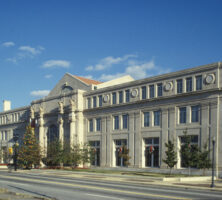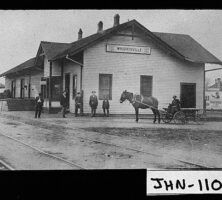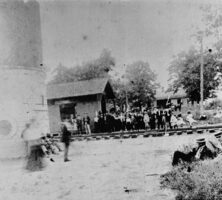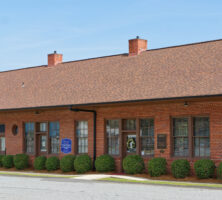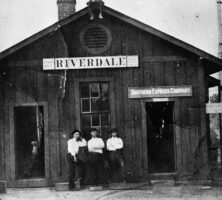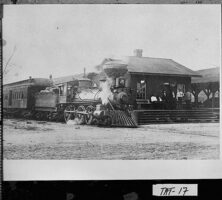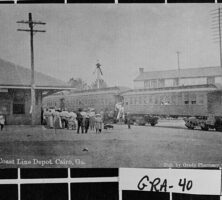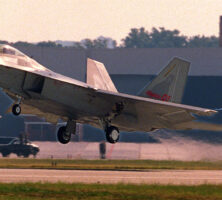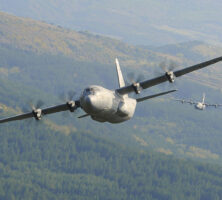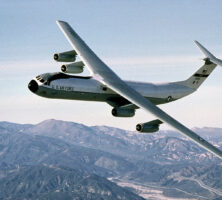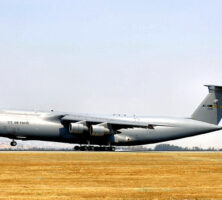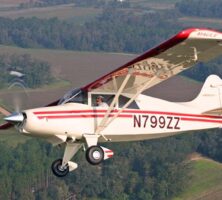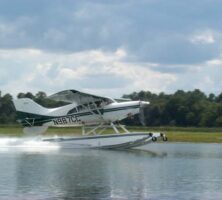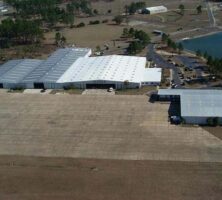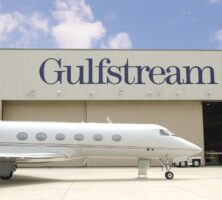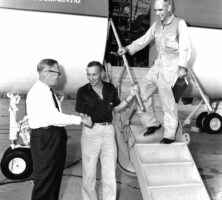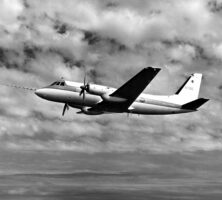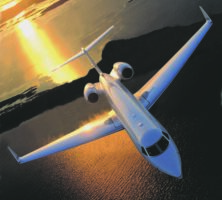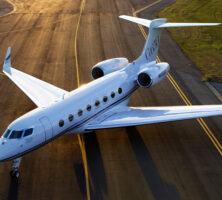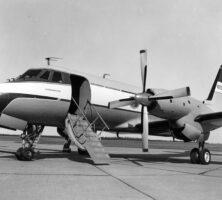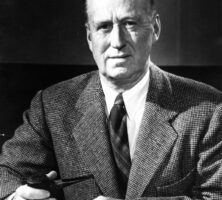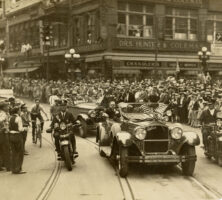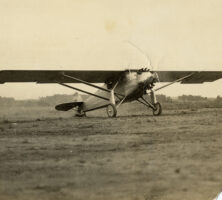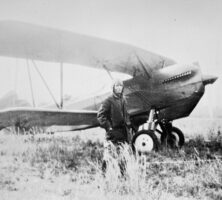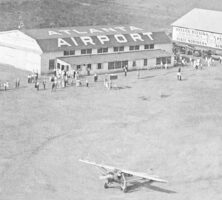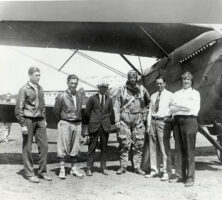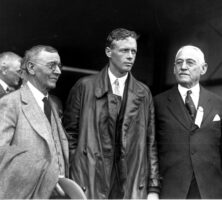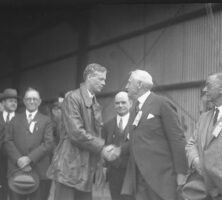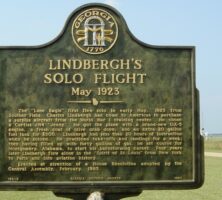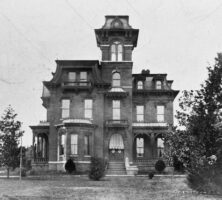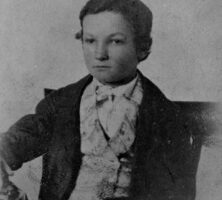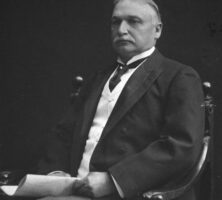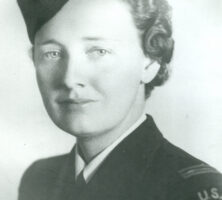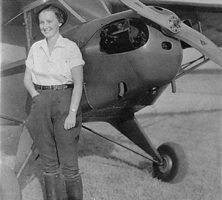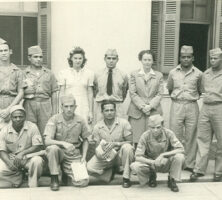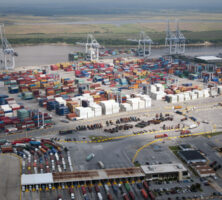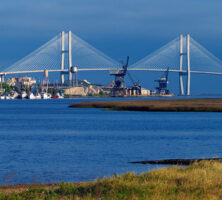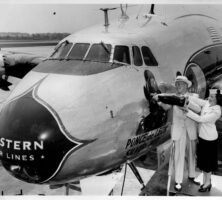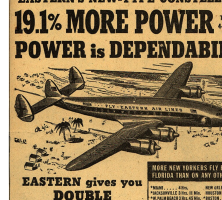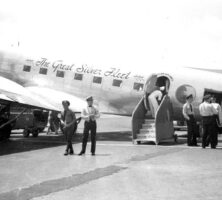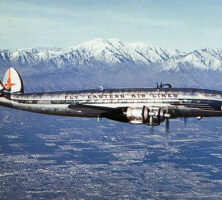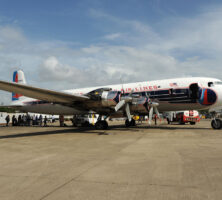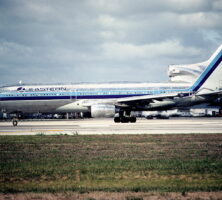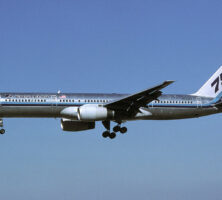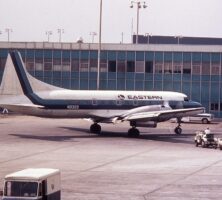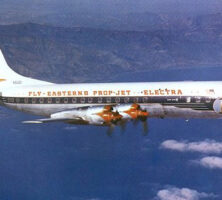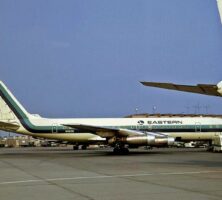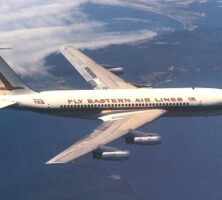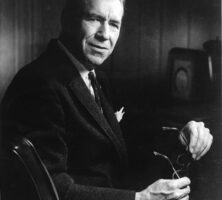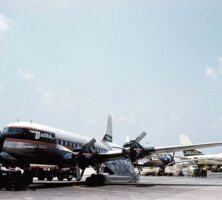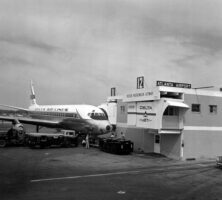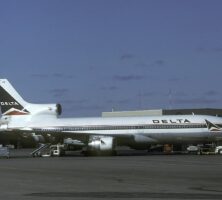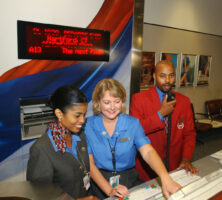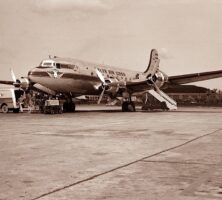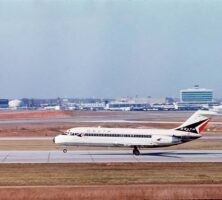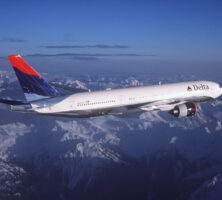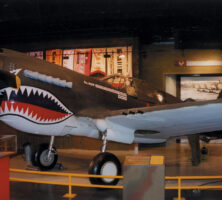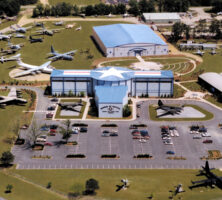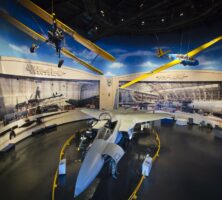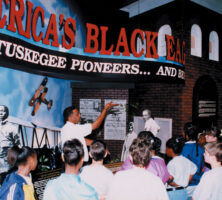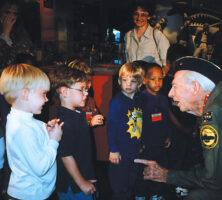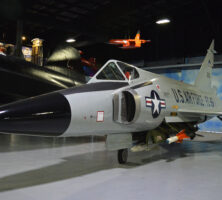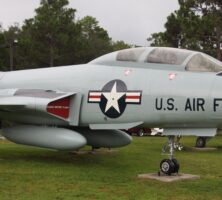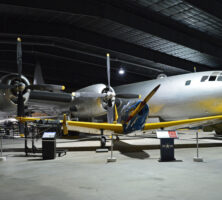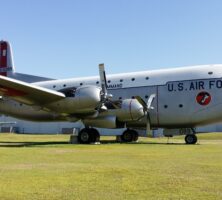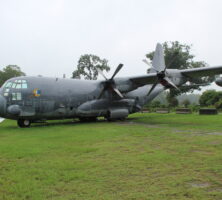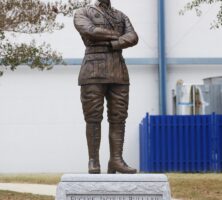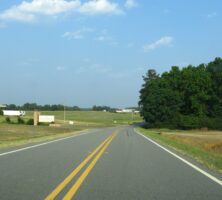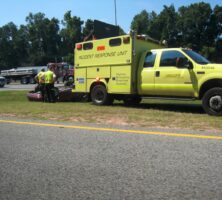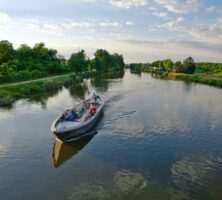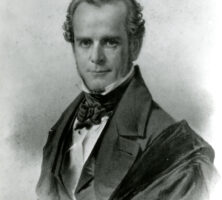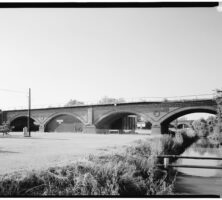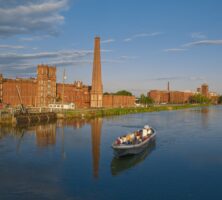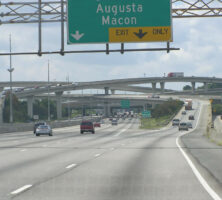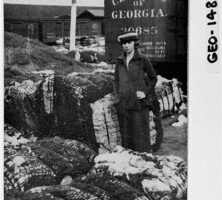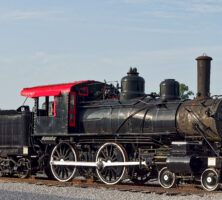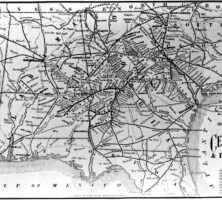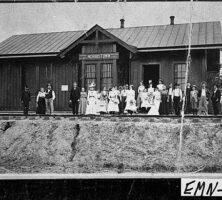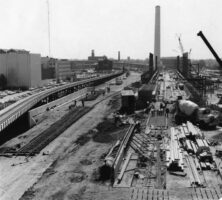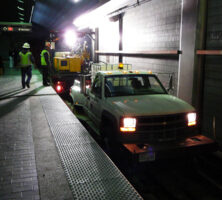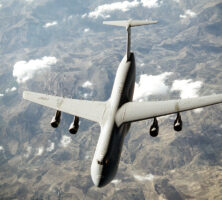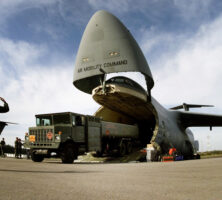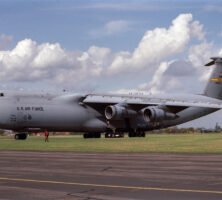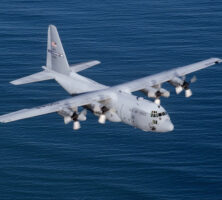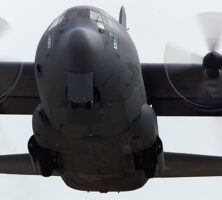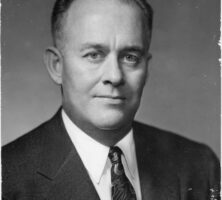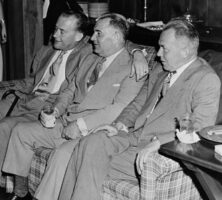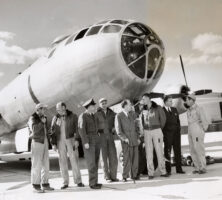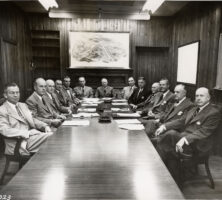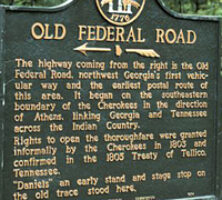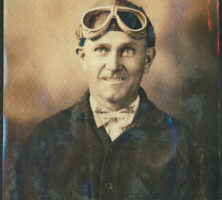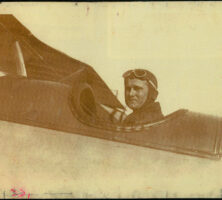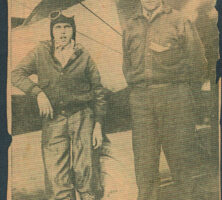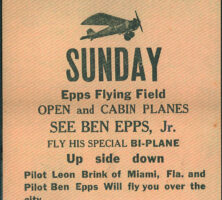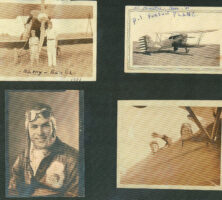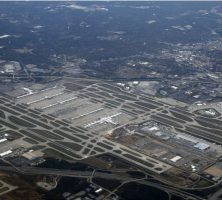The New Georgia Encyclopedia is supported by funding from A More Perfect Union, a special initiative of the National Endowment for the Humanities.
John D. Gray was the first major railroad contractor in the South and served as president of the Monroe Railroad in Georgia. During the Civil War he manufactured weaponry for the Confederacy.
Courtesy of Nancy Eubanks
The New Georgia Encyclopedia does not hold the copyright for this media resource and can neither grant nor deny permission to republish or reproduce the image online or in print. All requests for permission to publish or reproduce the resource must be submitted to the rights holder.
Passengers pose for a photograph, circa 1901, at Gallemore, a community in Twiggs County located between Macon and Danville. Railroad construction played a key role in the settlement patterns of Twiggs County in the late nineteenth and early twentieth centuries.
Courtesy of Georgia Archives, Vanishing Georgia, #
bib050.
The New Georgia Encyclopedia does not hold the copyright for this media resource and can neither grant nor deny permission to republish or reproduce the image online or in print. Requests for permission to publish or reproduce the resource should be submitted to the Georgia Archives.
The Central of Georgia Railway overpass in Savannah crosses the Savannah-Ogeechee Canal, shown around 1888. The bridge still exists in Savannah today.
Courtesy of Georgia Historical Society, Georgia Historical Society Collection of Photographs, 1870-1960, #GHS 1361PH-28-11-5395.
The New Georgia Encyclopedia does not hold the copyright for this media resource and can neither grant nor deny permission to republish or reproduce the image online or in print. All requests for permission to publish or reproduce the resource must be submitted to Georgia Historical Society.
A Norfolk Southern engine is pictured in 2007. Norfolk Southern and CSX are the only major railroad lines still operating in Georgia.
Photograph from Wikimedia
The New Georgia Encyclopedia does not hold the copyright for this media resource and can neither grant nor deny permission to republish or reproduce the image online or in print. All requests for permission to publish or reproduce the resource must be submitted to the rights holder.
A Central of Georgia Railway train stops at the depot in Colquitt, the seat of Miller County, around 1890. The only incorporated town in the county, Colquitt was named in honor of preacher and politician Walter Terry Colquitt.
Courtesy of Georgia Archives, Vanishing Georgia, #
mil001.
The New Georgia Encyclopedia does not hold the copyright for this media resource and can neither grant nor deny permission to republish or reproduce the image online or in print. Requests for permission to publish or reproduce the resource should be submitted to the Georgia Archives.
Gaining control of the railroads leading into and out of Atlanta was key to Union victory during the Civil War. On June 3, 1864, Union general William T. Sherman overcame the Confederates at Allatoona Pass. The Allatoona train depot appears in the center of this 1864 photograph, taken by George N. Barnard.
Courtesy of U.S. National Archives and Records Administration
The New Georgia Encyclopedia does not hold the copyright for this media resource and can neither grant nor deny permission to republish or reproduce the image online or in print. All requests for permission to publish or reproduce the resource must be submitted to the rights holder.
Bystanders greet the arrival of the first train on the Tifton, Thomasville, and Gulf Railroad in Thomasville, on July 20, 1900.
Courtesy of Georgia Archives, Vanishing Georgia, #
tho186a.
The New Georgia Encyclopedia does not hold the copyright for this media resource and can neither grant nor deny permission to republish or reproduce the image online or in print. Requests for permission to publish or reproduce the resource should be submitted to the Georgia Archives.
The East and West Railroad, built between Cartersville and Cedartown around 1900, is one of several railroads that came to Polk County in the late nineteenth and early twentieth centuries.
Courtesy of Georgia Archives, Vanishing Georgia, #
plk073-84.
The New Georgia Encyclopedia does not hold the copyright for this media resource and can neither grant nor deny permission to republish or reproduce the image online or in print. Requests for permission to publish or reproduce the resource should be submitted to the Georgia Archives.
A portion of the Southern Railroad known as the North Broad Curve, photographed in 1908, winds through Stephens County near Toccoa. Economic growth in Toccoa, which was dubbed the "Furniture, Thread, and Steel City," was spurred by its close proximity to the railroad running between Atlanta and Charlotte, North Carolina.
Courtesy of Georgia Archives, Vanishing Georgia, #
stp044.
The New Georgia Encyclopedia does not hold the copyright for this media resource and can neither grant nor deny permission to republish or reproduce the image online or in print. Requests for permission to publish or reproduce the resource should be submitted to the Georgia Archives.
The depot at Bremen in Haralson County, pictured circa 1925, was built for the Southern Railway. Norfolk Southern, which bought Southern, still uses the lines for its freight trains.
Courtesy of Georgia Archives, Vanishing Georgia, #
hrl019.
The New Georgia Encyclopedia does not hold the copyright for this media resource and can neither grant nor deny permission to republish or reproduce the image online or in print. Requests for permission to publish or reproduce the resource should be submitted to the Georgia Archives.
The Atlanta terminal station. Railroads expanded in Atlanta during the 1840s, making the city a commerce and transportation hub.
Courtesy of Boston Public Library, Tichnor Brothers Postcard Collection.
The New Georgia Encyclopedia does not hold the copyright for this media resource and can neither grant nor deny permission to republish or reproduce the image online or in print. All requests for permission to publish or reproduce the resource must be submitted to the rights holder.
Amtrak's Crescent train is shown pulling into the Brookwood Station in Atlanta in 2000. The Crescent route runs from New York City to New Orleans, Louisiana. Passenger service is available in Georgia through two Amtrak routes.
Photograph by Loco Steve
The New Georgia Encyclopedia does not hold the copyright for this media resource and can neither grant nor deny permission to republish or reproduce the image online or in print. All requests for permission to publish or reproduce the resource must be submitted to the rights holder.
The Chattanooga, Rome, and Columbus Railroad reached Chattooga County in 1889, with lines to Summerville, Lyerly, and Trion. The original depot was built the same year. In 1901 the CR&C merged with the Central of Georgia. The depot, pictured in 2004, was placed on the National Register of Historic Places in 1992.
Photograph by Shelia J. Cothran, City of Summerville
The New Georgia Encyclopedia does not hold the copyright for this media resource and can neither grant nor deny permission to republish or reproduce the image online or in print. All requests for permission to publish or reproduce the resource must be submitted to the rights holder.
Local leaders named the city of Waycross after the many roads crossing here in 1874. The area was once known as Old Nine, or Number Nine, after the railroad station number.
Photograph by J. Stephen Conn
The New Georgia Encyclopedia does not hold the copyright for this media resource and can neither grant nor deny permission to republish or reproduce the image online or in print. All requests for permission to publish or reproduce the resource must be submitted to the rights holder.
Five men and a dog, pictured circa 1907, stand on the platform of the train depot in Sparks, an incorporated city in Cook County. The town was established as a train stop at the beginning of the twentieth century.
Courtesy of Georgia Archives, Vanishing Georgia, #
cok004.
The New Georgia Encyclopedia does not hold the copyright for this media resource and can neither grant nor deny permission to republish or reproduce the image online or in print. Requests for permission to publish or reproduce the resource should be submitted to the Georgia Archives.
The Blue Ridge Scenic Railway transports tourists on excursion trips between Blue Ridge, the seat of Fannin County, and McCaysville. The train operates each year from April through December.
Image from Thomas Hawk
The New Georgia Encyclopedia does not hold the copyright for this media resource and can neither grant nor deny permission to republish or reproduce the image online or in print. All requests for permission to publish or reproduce the resource must be submitted to the rights holder.
A Seaboard Air Line Railway train pulls into the depot at Claxton, circa 1915. Claxton, the seat of Evans County, was founded when the first railroad came through the area in the 1890s.
Courtesy of Georgia Archives, Vanishing Georgia, #
eva010.
The New Georgia Encyclopedia does not hold the copyright for this media resource and can neither grant nor deny permission to republish or reproduce the image online or in print. Requests for permission to publish or reproduce the resource should be submitted to the Georgia Archives.
The New Georgia Encyclopedia does not hold the copyright for this media resource and can neither grant nor deny permission to republish or reproduce the image online or in print. All requests for permission to publish or reproduce the resource must be submitted to the rights holder.
The Winterville railroad depot, built in Clarke County in the late nineteenth century, was first known as "Six-mile Station" to indicate its distance from Athens. Later known as Winter's Station, the depot today houses Winterville's visitors center.
The New Georgia Encyclopedia does not hold the copyright for this media resource and can neither grant nor deny permission to republish or reproduce the image online or in print. Requests for permission to publish or reproduce the resource may need to be submitted to the Georgia Department of Community Affairs, Historic Preservation Division.
A rail line was first constructed in Stewart County in 1885, and the town of Richland grew up around the depot. Rails once connecting Americus to Montgomery, Alabama, and Columbus to Tallahassee, Florida, cross at Richland.
Courtesy of Matthew M. Moye
The New Georgia Encyclopedia does not hold the copyright for this media resource and can neither grant nor deny permission to republish or reproduce the image online or in print. All requests for permission to publish or reproduce the resource must be submitted to the rights holder.
The old train depot in Winder currently houses the city's chamber of commerce. The arrival in 1883 of the railroad spurred economic growth in Winder, which was renamed in appreciation of John H. Winder, the general manager of Seaboard Air Line Railway.
Image from Chris Pruitt
The New Georgia Encyclopedia does not hold the copyright for this media resource and can neither grant nor deny permission to republish or reproduce the image online or in print. All requests for permission to publish or reproduce the resource must be submitted to the rights holder.
The Blackshear railroad depot in Pierce County, added to the National Register of Historic Places in 2000, houses the chamber of commerce as well as the county's Heritage Museum and genealogical library. The depot was built in 1902.
Courtesy of John Walker Guss and Pierce County Historical and Genealogical Society, Inc.
The New Georgia Encyclopedia does not hold the copyright for this media resource and can neither grant nor deny permission to republish or reproduce the image online or in print. All requests for permission to publish or reproduce the resource must be submitted to the rights holder.
Passengers await a train at the U&N Depot in Canton around 1910. The arrival of the first railroad in 1879 brought tourists to the town, located in the foothills of the Blue Ridge Mountains, during the summer months.
Courtesy of Georgia Archives, Vanishing Georgia, #
crk026.
The New Georgia Encyclopedia does not hold the copyright for this media resource and can neither grant nor deny permission to republish or reproduce the image online or in print. Requests for permission to publish or reproduce the resource should be submitted to the Georgia Archives.
In 1992 Congress passed a transportation bill that provided enhancement funding for historic and natural resources associated with transportation routes and facilities, such as Macon's railroad depot.
The New Georgia Encyclopedia does not hold the copyright for this media resource and can neither grant nor deny permission to republish or reproduce the image online or in print. Requests for permission to publish or reproduce the resource may need to be submitted to the Georgia Department of Community Affairs, Historic Preservation Division.
The Wrightsville railroad depot, located in the seat of Johnson County, was built in 1900 by the Wrightsville and Tennille Railroad. Pictured circa 1915, the depot was restored duringthe 1990s and today houses the Wrightsville–Johnson County Chamber of Commerce and the Johnson County Development Authority.
Courtesy of Georgia Archives, Vanishing Georgia, #
jhn110.
The New Georgia Encyclopedia does not hold the copyright for this media resource and can neither grant nor deny permission to republish or reproduce the image online or in print. Requests for permission to publish or reproduce the resource should be submitted to the Georgia Archives.
This depot at Forest Park, shown circa 1900, was one of the stops along the railroad to Jonesboro, in Clayton County.
Courtesy of Georgia Archives, Vanishing Georgia, #clt056-84.
The New Georgia Encyclopedia does not hold the copyright for this media resource and can neither grant nor deny permission to republish or reproduce the image online or in print. Requests for permission to publish or reproduce the resource should be submitted to the Georgia Archives.
The Warner Robins railroad depot was created during World War II and became a critical site for the war effort. The town of Warner Robins grew up around the depot.
Image from Jud McCranie, Wikimedia Commons
The New Georgia Encyclopedia does not hold the copyright for this media resource and can neither grant nor deny permission to republish or reproduce the image online or in print. All requests for permission to publish or reproduce the resource must be submitted to the rights holder.
The train depot in Millen, in Jenkins County, was destroyed by Union forces during the Civil War and later rebuilt. Today the depot houses the "Olde Freight Depot Museum."
Courtesy of Theron Cates, Millen
The New Georgia Encyclopedia does not hold the copyright for this media resource and can neither grant nor deny permission to republish or reproduce the image online or in print. All requests for permission to publish or reproduce the resource must be submitted to the rights holder.
The Riverdale depot of the Southern Express Company railroad system was dismantled in 1939. Pictured, left to right: Henry McElroy; A. O. Bowles, railway agent and station master; and M. Vassa McConnell, postmaster. Leon Hancock on roof.
Courtesy of Georgia Archives, Vanishing Georgia, # clt027-84.
The New Georgia Encyclopedia does not hold the copyright for this media resource and can neither grant nor deny permission to republish or reproduce the image online or in print. Requests for permission to publish or reproduce the resource should be submitted to the Georgia Archives.
A Register and Glennville train, pictured in 1906, stops at the depot in Glennville, today the largest city in Tattnall County. The R&G Railroad was renamed the East Georgia Railway in 1914.
Courtesy of Georgia Archives, Vanishing Georgia, #
tat017.
The New Georgia Encyclopedia does not hold the copyright for this media resource and can neither grant nor deny permission to republish or reproduce the image online or in print. Requests for permission to publish or reproduce the resource should be submitted to the Georgia Archives.
The railroad depot in Juliette, in Monroe County, is pictured circa 1900.
Courtesy of Georgia Archives, Vanishing Georgia, #
mnr183.
The New Georgia Encyclopedia does not hold the copyright for this media resource and can neither grant nor deny permission to republish or reproduce the image online or in print. Requests for permission to publish or reproduce the resource should be submitted to the Georgia Archives.
People gather outside the Atlantic Coast Line Depot in Cairo, the seat of Grady County, circa 1916. With the arrival of the railroads in the county, area residents were able to market their agricultural products, including timber.
Courtesy of Georgia Archives, Vanishing Georgia, #
gra040.
The New Georgia Encyclopedia does not hold the copyright for this media resource and can neither grant nor deny permission to republish or reproduce the image online or in print. Requests for permission to publish or reproduce the resource should be submitted to the Georgia Archives.
The F-22 fighter jet flew for the first time on September 7, 1997, from Dobbins Air Reserve Base in Marietta. At the beginning of this test flight, which lasted more than an hour, the aircraft reached an altitude of 15,000 feet in less than three minutes.
Courtesy of Atlanta Journal-Constitution.
The New Georgia Encyclopedia does not hold the copyright for this media resource and can neither grant nor deny permission to republish or reproduce the image online or in print. All requests for permission to publish or reproduce the resource must be submitted to the Atlanta Journal-Constitution.
The New Georgia Encyclopedia does not hold the copyright for this media resource and can neither grant nor deny permission to republish or reproduce the image online or in print. All requests for permission to publish or reproduce the resource must be submitted to the rights holder.
Compared with earlier models of C-130 Hercules cargo planes, Lockheed Martin's C-130J has a higher cruising altitude and can reach 28,000 feet in fourteen minutes.
Photograph by Wikimedia
The New Georgia Encyclopedia does not hold the copyright for this media resource and can neither grant nor deny permission to republish or reproduce the image online or in print. All requests for permission to publish or reproduce the resource must be submitted to the rights holder.
In the mid-1960s the Lockheed C-141 Starlifter became the first all-jet cargo plane to deploy in the U.S. Air Force. It quickly became the air force's airlift mainstay. Its wide body can accommodate a variety of missions, including personnel and equipment transport, disaster relief, and cargo supplies.
Photograph by Wikimedia
The New Georgia Encyclopedia does not hold the copyright for this media resource and can neither grant nor deny permission to republish or reproduce the image online or in print. All requests for permission to publish or reproduce the resource must be submitted to the rights holder.
One of the biggest aircraft ever made, Lockheed's C-5 Galaxy first flew in 1968. The plane has a wingspan of nearly 223 feet, is 247 feet long and 65 feet high, and can carry 135 tons of cargo.
Photograph from the U.S. Air Force
The New Georgia Encyclopedia does not hold the copyright for this media resource and can neither grant nor deny permission to republish or reproduce the image online or in print. All requests for permission to publish or reproduce the resource must be submitted to the rights holder.
The Maule M-4-180V, an updated model of Maule Air's M-4 design, was released in 2005. Maule Air, based in Moultrie, is an aircraft manufacturer owned by the family of B. D. Maule, who founded the company in 1941.
Courtesy of Maule Air
The New Georgia Encyclopedia does not hold the copyright for this media resource and can neither grant nor deny permission to republish or reproduce the image online or in print. All requests for permission to publish or reproduce the resource must be submitted to the rights holder.
The Maule taildragger model M-7-420AC lands on water. Maule Air, based in Moultrie, manufactures twenty models of STOL (Short Takeoff Or Landing) airplanes that can be used in a variety of terrains.
Courtesy of Maule Air
The New Georgia Encyclopedia does not hold the copyright for this media resource and can neither grant nor deny permission to republish or reproduce the image online or in print. All requests for permission to publish or reproduce the resource must be submitted to the rights holder.
The New Georgia Encyclopedia does not hold the copyright for this media resource and can neither grant nor deny permission to republish or reproduce the image online or in print. All requests for permission to publish or reproduce the resource must be submitted to the rights holder.
The Maule Air factory was built at Spence Air Base in Moultrie by B. D. and June Maule in 1968. In addition to the factory buildings, the family constructed a lodge home and a lake on the grounds.
Courtesy of Maule Air
The New Georgia Encyclopedia does not hold the copyright for this media resource and can neither grant nor deny permission to republish or reproduce the image online or in print. All requests for permission to publish or reproduce the resource must be submitted to the rights holder.
The Gulfstream IV-SP, pictured here, is part of the Gulfstream fleet of aircraft produced by the Gulfstream Aerospace Corporation, based in Savannah.
Courtesy of Gulfstream Aersopace Corporation
The New Georgia Encyclopedia does not hold the copyright for this media resource and can neither grant nor deny permission to republish or reproduce the image online or in print. All requests for permission to publish or reproduce the resource must be submitted to the rights holder.
Leroy Grumman (left) congratulates pilots Fred Rowley (center) and Carl Alber after their successful initial flight of the new Gulfstream I model in 1958. The aircraft, which seated twelve, could reach a maximum speed of 350 miles per hour.
Courtesy of Northrop Grumman History Center
The New Georgia Encyclopedia does not hold the copyright for this media resource and can neither grant nor deny permission to republish or reproduce the image online or in print. All requests for permission to publish or reproduce the resource must be submitted to the rights holder.
On August 14, 1958, the business aircraft Gulfstream I took its maiden flight. The plane represented a shift away from a sole focus on military aircraft for the Grumman Aircraft Engineering Company, which later became Gulfstream Aerospace Corporation, based in Savannah.
Courtesy of Northrop Grumman HIstory Center
The New Georgia Encyclopedia does not hold the copyright for this media resource and can neither grant nor deny permission to republish or reproduce the image online or in print. All requests for permission to publish or reproduce the resource must be submitted to the rights holder.
The New Georgia Encyclopedia does not hold the copyright for this media resource and can neither grant nor deny permission to republish or reproduce the image online or in print. All requests for permission to publish or reproduce the resource must be submitted to the rights holder.
The G550 is Gulfstream Aerospace Corporation's most advanced passenger jet, boasting a range of 6,750 nautical miles at .885 Mach.
Courtesy of Gulfstream Aerospace Corporation
The New Georgia Encyclopedia does not hold the copyright for this media resource and can neither grant nor deny permission to republish or reproduce the image online or in print. All requests for permission to publish or reproduce the resource must be submitted to the rights holder.
The G650 is the largest, most technologically advanced aircraft in the Gulfstream fleet. The plane is capable of traveling 7,000 nautical miles at 0.85 Mach or 5,000 nautical miles at 0.925 Mach.
Image from Charly W. Karl
The New Georgia Encyclopedia does not hold the copyright for this media resource and can neither grant nor deny permission to republish or reproduce the image online or in print. All requests for permission to publish or reproduce the resource must be submitted to the rights holder.
The New Georgia Encyclopedia does not hold the copyright for this media resource and can neither grant nor deny permission to republish or reproduce the image online or in print. All requests for permission to publish or reproduce the resource must be submitted to the rights holder.
The New Georgia Encyclopedia does not hold the copyright for this media resource and can neither grant nor deny permission to republish or reproduce the image online or in print. All requests for permission to publish or reproduce the resource must be submitted to the rights holder.
Gulfstream I, the first aircraft of the Gulfstream fleet, was designed in 1957 by the Grumman Aircraft Engineering Company and took its maiden flight in 1958. Today the fleet is produced by the Gulfstream Aerospace Corporation, based in Savannah.
Courtesy of Northrop Grumman History Center
The New Georgia Encyclopedia does not hold the copyright for this media resource and can neither grant nor deny permission to republish or reproduce the image online or in print. All requests for permission to publish or reproduce the resource must be submitted to the rights holder.
The New Georgia Encyclopedia does not hold the copyright for this media resource and can neither grant nor deny permission to republish or reproduce the image online or in print. All requests for permission to publish or reproduce the resource must be submitted to the rights holder.
Having served as vice chairman of Gulfstream Aerospace Corporation since 1995, Bryan T. Moss was appointed president in 2003 and served until his retirement in 2008. A graduate of the Georgia Institute of Technology, Moss had previously worked for the Lockheed-Georgia Company.
Courtesy of Gulfstream Aerospace Corporation
The New Georgia Encyclopedia does not hold the copyright for this media resource and can neither grant nor deny permission to republish or reproduce the image online or in print. All requests for permission to publish or reproduce the resource must be submitted to the rights holder.
Leroy Grumman and his business partner, Leon Swirbul, founded the Grumman Aircraft Engineering Company (later Gulfstream Aerospace Corporation) on Long Island, New York, in 1930. The company introduced the Gulfstream fleet of aircraft in 1958 and in 1967 moved its headquarters to Savannah.
Courtesy of Northrop Grumman History Center
The New Georgia Encyclopedia does not hold the copyright for this media resource and can neither grant nor deny permission to republish or reproduce the image online or in print. All requests for permission to publish or reproduce the resource must be submitted to the rights holder.
A man-made channel known as the Atlantic Intracoastal Waterway allows watercraft to navigate the marshes separating Georgia's barrier islands from the mainland.
Courtesy of Explore Georgia, Photograph by Ralph Daniel.
The New Georgia Encyclopedia does not hold the copyright for this media resource and can neither grant nor deny permission to republish or reproduce the image online or in print. Requests for permission to publish or reproduce the resource may need to be submitted to Explore Georgia.
The New Georgia Encyclopedia does not hold the copyright for this media resource and can neither grant nor deny permission to republish or reproduce the image online or in print. All requests for permission to publish or reproduce the resource must be submitted to the rights holder.
Charles Lindbergh parades through downtown Atlanta where crowds line the street on October 11, 1927. He is on his way to Grant Field at Georgia Tech, where he will deliver a message on the commercial potential of aviation to a crowd of 20,000 people.
Courtesy of Atlanta History Center.
The New Georgia Encyclopedia does not hold the copyright for this media resource and can neither grant nor deny permission to republish or reproduce the image online or in print. Requests for permission to publish or reproduce the resource should be submitted to the Atlanta History Center.
Charles Lindbergh's Spirit of St. Louis lands on the grass runway at Candler Field on October 11, 1927. The day was cloudy and rainy but that did not deter thousands from meeting Lindbergh at the field. The Spirit of St. Louis is now on display at the National Air and Space Museum of the Smithsonian Institution, in Washington, D.C.
Courtesy of Atlanta History Center.
The New Georgia Encyclopedia does not hold the copyright for this media resource and can neither grant nor deny permission to republish or reproduce the image online or in print. Requests for permission to publish or reproduce the resource should be submitted to the Atlanta History Center.
The groundbreaking aviator Charles Lindbergh stands beside an airplane on Sapelo Island. The photograph was probably taken around 1929, when Lindbergh paid a short visit to the island.
Courtesy of Georgia Archives, Vanishing Georgia, #sap058.
The New Georgia Encyclopedia does not hold the copyright for this media resource and can neither grant nor deny permission to republish or reproduce the image online or in print. Requests for permission to publish or reproduce the resource should be submitted to the Georgia Archives.
In this aerial photograph Charles Lindbergh prepares to take off from Candler Field on October 12, 1927, in the Spirit of St. Louis. He is bound for Spartanburg, South Carolina, the next stop on his triumphal tour.
Courtesy of Georgia Info, Digital Library of Georgia.
The New Georgia Encyclopedia does not hold the copyright for this media resource and can neither grant nor deny permission to republish or reproduce the image online or in print. Requests for permission to publish or reproduce the resource may need to be submitted to the Digital Library of Georgia.
October 12, 1927, was a sunny day, perfect for flying. Charles Lindbergh poses in his flight suit in front of a parked biplane (not to be confused with the Spirit of St. Louis) at Candler Field, ready for his departure. Second from the right is Doug Davis, who owned the hangar where the Spirit of St. Louis was parked. William Lee, a U.S. mail pilot, stands to the far right.
Courtesy of Atlanta History Center.
The New Georgia Encyclopedia does not hold the copyright for this media resource and can neither grant nor deny permission to republish or reproduce the image online or in print. Requests for permission to publish or reproduce the resource should be submitted to the Atlanta History Center.
Charles Lindbergh poses with Georgia governor Lamartine Hardman (right) and Atlanta mayor Isaac N. Ragsdale (left) at Candler Field on October 11, 1927.
Courtesy of Atlanta Journal-Constitution.
The New Georgia Encyclopedia does not hold the copyright for this media resource and can neither grant nor deny permission to republish or reproduce the image online or in print. All requests for permission to publish or reproduce the resource must be submitted to the Atlanta Journal-Constitution.
Governor Lamartine Hardman (right) greeting aviator Charles Lindbergh (left) upon his arrival at Candler Field during his nationwide tour in 1927.
Courtesy of Atlanta History Center.
The New Georgia Encyclopedia does not hold the copyright for this media resource and can neither grant nor deny permission to republish or reproduce the image online or in print. Requests for permission to publish or reproduce the resource should be submitted to the Atlanta History Center.
In 1985 Americus celebrated "Lindbergh Days" with the dedication of a new state historical marker commemorating aviator Charles Lindbergh's first solo flight from Souther Field.
Courtesy of Ed Jackson
The New Georgia Encyclopedia does not hold the copyright for this media resource and can neither grant nor deny permission to republish or reproduce the image online or in print. All requests for permission to publish or reproduce the resource must be submitted to the rights holder.
The Inman family donated a portion of their wealth to many charitable causes in Atlanta, including several colleges, the Confederate Soldiers' Home, Grady Memorial Hospital, and this orphanage.
Courtesy of Atlanta History Center.
The New Georgia Encyclopedia does not hold the copyright for this media resource and can neither grant nor deny permission to republish or reproduce the image online or in print. Requests for permission to publish or reproduce the resource should be submitted to the Atlanta History Center.
Hugh Inman, the youngest son of Shadrach W. Inman, sits for a portrait as a young boy. After the family moved to Atlanta in 1865, Hugh worked with his father to establish a dry goods store in the city.
Courtesy of Atlanta History Center.
The New Georgia Encyclopedia does not hold the copyright for this media resource and can neither grant nor deny permission to republish or reproduce the image online or in print. Requests for permission to publish or reproduce the resource should be submitted to the Atlanta History Center.
Four generations of the Inman family begin with (right to left) Shadrach W. Inman, Samuel M. Inman, Henry Arthur Inman, and Arthur Crew Inman. Shadrach arrived in Atlanta from east Tennessee in 1865 to join his brothers William H. and Walker P. Inman. The Inman family soon became among the most wealthy and prominent in the city.
Courtesy of Atlanta History Center.
The New Georgia Encyclopedia does not hold the copyright for this media resource and can neither grant nor deny permission to republish or reproduce the image online or in print. Requests for permission to publish or reproduce the resource should be submitted to the Atlanta History Center.
Samuel Inman, the oldest son of Shadrach W. Inman, opened a dry goods store in Augusta before becoming, along with his brother Hugh and friend Joel Hurt, an investor in railroads, streetcars, and banks in Atlanta during the 1890s.
Courtesy of Atlanta History Center.
The New Georgia Encyclopedia does not hold the copyright for this media resource and can neither grant nor deny permission to republish or reproduce the image online or in print. Requests for permission to publish or reproduce the resource should be submitted to the Atlanta History Center.
The Entomopter may one day fly in the thin atmosphere of Mars, collecting data that rovers and other spacecraft are unable to find.
The New Georgia Encyclopedia does not hold the copyright for this media resource and can neither grant nor deny permission to republish or reproduce the image online or in print. All requests for permission to publish or reproduce the resource must be submitted to the rights holder.
Eleanor Roosevelt inspects the British Air Transport Auxiliary pilots in England, October 26, 1942. Hazel Raines, second from the left, flew as a ferry pilot for the ATA during World War II.
Courtesy Georgia Aviation Hall of Fame
The New Georgia Encyclopedia does not hold the copyright for this media resource and can neither grant nor deny permission to republish or reproduce the image online or in print. All requests for permission to publish or reproduce the resource must be submitted to the rights holder.
One of only twenty-five women chosen to wear the Air Transport Auxiliary uniform, Hazel Raines logged more flight hours than other pilot in the ATA.
Courtesy Georgia Aviation Hall of Fame
The New Georgia Encyclopedia does not hold the copyright for this media resource and can neither grant nor deny permission to republish or reproduce the image online or in print. All requests for permission to publish or reproduce the resource must be submitted to the rights holder.
Hazel Raines was the first woman in Georgia to earn a pilot's license. She flew as a ferry pilot in World War II for the British, and in 1943 joined the Women Airforce Service Pilots (known as WASPs) in Texas.
Courtesy of Georgia Women of Achievement.
The New Georgia Encyclopedia does not hold the copyright for this media resource and can neither grant nor deny permission to republish or reproduce the image online or in print. Requests for permission to publish or reproduce the resource may need to be submitted to Georgia Women of Achievement.
After the WASPs were deactivated in 1944, Hazel Raines (back row, fourth from right) became an instructor with the Brazilian Air Ministry. On August 4, 1945, she received a certificate from the J. P. Riddle Company Instructors' School in Miami, Florida, where she completed a course on the teaching of technical subjects in Portuguese.
Courtesy Georgia Aviation Hall of Fame
The New Georgia Encyclopedia does not hold the copyright for this media resource and can neither grant nor deny permission to republish or reproduce the image online or in print. All requests for permission to publish or reproduce the resource must be submitted to the rights holder.
One of the busiest ports in the United States, Savannah handles nearly 10 percent of total U.S. containerized cargo volume.
Photograph by the U.S. Army Corps of Engineers
The New Georgia Encyclopedia does not hold the copyright for this media resource and can neither grant nor deny permission to republish or reproduce the image online or in print. All requests for permission to publish or reproduce the resource must be submitted to the rights holder.
The Port of Brunswick comprises three deepwater terminals. The port's reputation for productivity and efficiency is heightened by its position as one of the fastest growing auto and heavy machinery ports in North America.
Photograph by Jaxfl
The New Georgia Encyclopedia does not hold the copyright for this media resource and can neither grant nor deny permission to republish or reproduce the image online or in print. All requests for permission to publish or reproduce the resource must be submitted to the rights holder.
The Ponce de Leon, an Eastern Air Lines Constellation passenger plane, is christened with a bottle of Cola-Cola in 1951 by Fred B. Moore and Paula Reid. The Constellation was the first aircraft purchased by Eastern's president Eddie Rickenbacker during the company's transition from military to passenger service after World War II.
The New Georgia Encyclopedia does not hold the copyright for this media resource and can neither grant nor deny permission to republish or reproduce the image online or in print. Requests for permission to publish or reproduce the resource should be submitted to Special Collections and Archives at Georgia State University.
The Boeing 727 "Whisper Jet" became a workhorse in the passenger industry after it entered service for Eastern in 1964. Its nickname came from its three quiet engines, which offered high-powered performance. It held 138 seats and cruised at 605 miles per hour.
Reprinted by permission of Boeing Company
The New Georgia Encyclopedia does not hold the copyright for this media resource and can neither grant nor deny permission to republish or reproduce the image online or in print. All requests for permission to publish or reproduce the resource must be submitted to the rights holder.
Passengers boarding an Eastern airplane onto the tarmac at Atlanta Municipal Airport in the 1950s, with Miss Atlanta attending.
Courtesy of Special Collections & Archives, Georgia State University Library, Carolyn Lee Wills Collection of Eastern Airlines' Southern Region Public Relations Office records, Southern Labor Archives.
The New Georgia Encyclopedia does not hold the copyright for this media resource and can neither grant nor deny permission to republish or reproduce the image online or in print. Requests for permission to publish or reproduce the resource should be submitted to Special Collections and Archives at Georgia State University.
A 1949 advertisement for Eastern Air Transport promotes service from New York City to Florida.
Courtesy of Duke University, Ad*Access Collection.
The New Georgia Encyclopedia does not hold the copyright for this media resource and can neither grant nor deny permission to republish or reproduce the image online or in print. All requests for permission to publish or reproduce the resource must be submitted to the rights holder.
The Douglas DC-3 revolutionized air passenger transportation. Introduced in 1936, it carried up to twenty-eight passengers at a cruising speed of 170 miles per hour. It was the main passenger transport in the United States until it was replaced after World War II by the DC-4, DC-6, and DC-7.
Photograph by Wikimedia
The New Georgia Encyclopedia does not hold the copyright for this media resource and can neither grant nor deny permission to republish or reproduce the image online or in print. All requests for permission to publish or reproduce the resource must be submitted to the rights holder.
The tritailed four-engine Constellation, originally developed by Lockheed for use by the armed services, was first adapted for passenger service by Eastern in 1947. The 1950s "Super Constellation" was an upgrade. The "Connie" held seventy-two seats in its pressurized cabin and cruised at 327 miles per hour.
Reprinted by permission of Lockheed Company
The New Georgia Encyclopedia does not hold the copyright for this media resource and can neither grant nor deny permission to republish or reproduce the image online or in print. All requests for permission to publish or reproduce the resource must be submitted to the rights holder.
The Douglas DC-7 represented the most important development in airline technology since the DC-3, a pre-World War II plane. With its pressurized cabin, the DC-7 offered a high standard of comfort to air travel and was widely adopted among the major airline carriers for long-haul traffic. It held sixty-nine seats and cruised at 360 miles per hour.
Photograph by Wikimedia
The New Georgia Encyclopedia does not hold the copyright for this media resource and can neither grant nor deny permission to republish or reproduce the image online or in print. All requests for permission to publish or reproduce the resource must be submitted to the rights holder.
The Lockheed L-1011 TriStar began flying for Eastern Air Lines in 1972. The TriStar was a wide-body, three-engine jet with intercontinental range. It held 250 seats and cruised at 552 miles per hour.
Photograph from Wikimedia
The New Georgia Encyclopedia does not hold the copyright for this media resource and can neither grant nor deny permission to republish or reproduce the image online or in print. All requests for permission to publish or reproduce the resource must be submitted to the rights holder.
The two-engine Boeing 757 entered service in the early 1980s, replacing the aging 727.
Photograph by Wikimedia
The New Georgia Encyclopedia does not hold the copyright for this media resource and can neither grant nor deny permission to republish or reproduce the image online or in print. All requests for permission to publish or reproduce the resource must be submitted to the rights holder.
The Convair 440 was a post-World War II innovation for short-haul traffic. For its time the 440 was economical, comfortable, and fast. It was also well suited to Eastern's connecting routes among intermediate-sized cities. It held forty-four seats and cruised at 284 miles per hour.
Photograph by Wikimedia
The New Georgia Encyclopedia does not hold the copyright for this media resource and can neither grant nor deny permission to republish or reproduce the image online or in print. All requests for permission to publish or reproduce the resource must be submitted to the rights holder.
In 1959 Eastern began flying the Lockheed Electra, a four-engine turboprop, carrying sixty-six seats and cruising at 370 miles per hour.
Reprinted by permission of Lockheed Company
The New Georgia Encyclopedia does not hold the copyright for this media resource and can neither grant nor deny permission to republish or reproduce the image online or in print. All requests for permission to publish or reproduce the resource must be submitted to the rights holder.
The Douglas DC-8 (together with the Boeing 707) inaugurated the jet age in the airline industry. Eastern placed its first orders for the new plane in 1960. The jet replaced the DC-7 and remained in service for years, benefiting from equipment upgrades and a "stretched" fuselage to accommodate more passengers. It held 119 seats and cruised at 590 miles per hour.
Photograph by Wikimedia
The New Georgia Encyclopedia does not hold the copyright for this media resource and can neither grant nor deny permission to republish or reproduce the image online or in print. All requests for permission to publish or reproduce the resource must be submitted to the rights holder.
The Boeing 720 offered Eastern a long-haul jet liner, entering service in 1961. The Boeing 720, a shortened version of the 707, held 140 seats and cruised at 600 miles per hour.
Reprinted by permission of Boeing Company
The New Georgia Encyclopedia does not hold the copyright for this media resource and can neither grant nor deny permission to republish or reproduce the image online or in print. All requests for permission to publish or reproduce the resource must be submitted to the rights holder.
A two-engine, wide-body jet with transcontinental range, the Boeing 767 entered service with Delta in 1982. This model was the first to fly for Delta.
Reprinted by permission of Delta Air Lines
The New Georgia Encyclopedia does not hold the copyright for this media resource and can neither grant nor deny permission to republish or reproduce the image online or in print. All requests for permission to publish or reproduce the resource must be submitted to the rights holder.
The New Georgia Encyclopedia does not hold the copyright for this media resource and can neither grant nor deny permission to republish or reproduce the image online or in print. All requests for permission to publish or reproduce the resource must be submitted to the rights holder.
The New Georgia Encyclopedia does not hold the copyright for this media resource and can neither grant nor deny permission to republish or reproduce the image online or in print. All requests for permission to publish or reproduce the resource must be submitted to the rights holder.
C. E. Woolman's name is synonymous with Delta Air Lines. He raised the capital for the purchase of the company in 1928 (named Delta Air Transport, Inc. in 1929) and stepped down as chief executive officer in 1965.
Reprinted by permission of Delta Air Lines
The New Georgia Encyclopedia does not hold the copyright for this media resource and can neither grant nor deny permission to republish or reproduce the image online or in print. All requests for permission to publish or reproduce the resource must be submitted to the rights holder.
The New Georgia Encyclopedia does not hold the copyright for this media resource and can neither grant nor deny permission to republish or reproduce the image online or in print. All requests for permission to publish or reproduce the resource must be submitted to the rights holder.
The Douglas DC-7 brought yet another development in passenger flight. With a pressurized cabin that allowed it to fly "above the weather," the sixty-nine-seat DC-7 cruised at 360 miles per hour. The cabin and services offered an air of affluence, which Delta dubbed its "Royal Service."
Reprinted by permission of Delta Air Lines
The New Georgia Encyclopedia does not hold the copyright for this media resource and can neither grant nor deny permission to republish or reproduce the image online or in print. All requests for permission to publish or reproduce the resource must be submitted to the rights holder.
The New Georgia Encyclopedia does not hold the copyright for this media resource and can neither grant nor deny permission to republish or reproduce the image online or in print. All requests for permission to publish or reproduce the resource must be submitted to the rights holder.
The DC-8 inaugurated Delta's transition to jet service in 1959. Cruising at 590 miles per hour with 119 seats, the DC-8 was an important step in Delta's rise as a nationally competitive airline. The DC-8 pictured is at a passenger boarding "jetway" at Hartsfield International Airport.
Reprinted by permission of Delta Air Lines
The New Georgia Encyclopedia does not hold the copyright for this media resource and can neither grant nor deny permission to republish or reproduce the image online or in print. All requests for permission to publish or reproduce the resource must be submitted to the rights holder.
The Lockheed L-1011 TriStar wide-body airliner entered service in 1973. In 1977 it inaugurated the company's Atlanta-London route. The TriStar held 241 seats and cruised at 552 mph.
Photograph from Wikimedia
The New Georgia Encyclopedia does not hold the copyright for this media resource and can neither grant nor deny permission to republish or reproduce the image online or in print. All requests for permission to publish or reproduce the resource must be submitted to the rights holder.
Delta employees board passengers at Hartsfield-Jackson Atlanta International Airport.
Reprinted by permission of Delta Air Lines
The New Georgia Encyclopedia does not hold the copyright for this media resource and can neither grant nor deny permission to republish or reproduce the image online or in print. All requests for permission to publish or reproduce the resource must be submitted to the rights holder.
The New Georgia Encyclopedia does not hold the copyright for this media resource and can neither grant nor deny permission to republish or reproduce the image online or in print. All requests for permission to publish or reproduce the resource must be submitted to the rights holder.
The Douglas DC-3 was the most important development in passenger air service before World War II. Widely adopted by the airline industry, the DC-3 introduced new standards of reliability, speed, efficiency, and comfort for passengers. The DC-3 carried up to twenty-eight passengers at a cruising speed of 180 miles per hour.
Reprinted by permission of Delta Air Lines
The New Georgia Encyclopedia does not hold the copyright for this media resource and can neither grant nor deny permission to republish or reproduce the image online or in print. All requests for permission to publish or reproduce the resource must be submitted to the rights holder.
The Douglas DC-4 was a post-World War II development that replaced the DC-3. With four engines, the DC-4 cruised at 215 miles per hour and held forty-four seats.
Photograph by Wikimedia
The New Georgia Encyclopedia does not hold the copyright for this media resource and can neither grant nor deny permission to republish or reproduce the image online or in print. All requests for permission to publish or reproduce the resource must be submitted to the rights holder.
The Douglas DC-9 was ideally suited to Delta's short-haul route system. With sixty-five seats and a cruising speed of 560 miles per hour, the DC-9 entered service in 1967. It stayed in service for the next two decades.
Reprinted by permission of Delta Air Lines
The New Georgia Encyclopedia does not hold the copyright for this media resource and can neither grant nor deny permission to republish or reproduce the image online or in print. All requests for permission to publish or reproduce the resource must be submitted to the rights holder.
The Boeing 777 is the newest Boeing-developed passenger plane and the most recent addition to Delta's fleet. Its two-isle cabin is smaller than that of the 747, but larger than all other twin- or tri-jet passenger aircraft.
Reprinted by permission of Delta Air Lines
The New Georgia Encyclopedia does not hold the copyright for this media resource and can neither grant nor deny permission to republish or reproduce the image online or in print. All requests for permission to publish or reproduce the resource must be submitted to the rights holder.
The P-40 was the major fighter for the Army Air Corps at the beginning of World War II. The P-40N, the fastest of the series, was the final production version. The aircraft on display was obtained by the Museum of Aviation in 1994 with help from the 653rd Combat Logistics Support Squadron and the Air Force Reserve.
Courtesy of the Museum of Aviation
The New Georgia Encyclopedia does not hold the copyright for this media resource and can neither grant nor deny permission to republish or reproduce the image online or in print. All requests for permission to publish or reproduce the resource must be submitted to the rights holder.
The Museum of Aviation covers fifty-one acres and includes open-air displays and hangars. The museum is located on the grounds of Robins Air Force Base in Warner Robins, ten miles south of Macon.
Courtesy of Museum of Aviation
The New Georgia Encyclopedia does not hold the copyright for this media resource and can neither grant nor deny permission to republish or reproduce the image online or in print. All requests for permission to publish or reproduce the resource must be submitted to the rights holder.
A TG-4A Glider (right) and a T-6G North American Texan (left) hover over an F-15 Eagle Fighter Jet in the Eagle Building rotunda of the Museum of Aviation.
Courtesy of Explore Georgia, Photograph by Ralph Daniel.
The New Georgia Encyclopedia does not hold the copyright for this media resource and can neither grant nor deny permission to republish or reproduce the image online or in print. Requests for permission to publish or reproduce the resource may need to be submitted to Explore Georgia.
A group of children listen to a lecture about the contribution of Black Americans to the World War II effort at the "America's Black Eagles: The Tuskegee Pioneers . . . and Beyond" Exhibit at the Museum of Aviation.
Courtesy of the Museum of Aviation
The New Georgia Encyclopedia does not hold the copyright for this media resource and can neither grant nor deny permission to republish or reproduce the image online or in print. All requests for permission to publish or reproduce the resource must be submitted to the rights holder.
A group of children learn about the suits pilots wear at the Museum of Aviation's Flight Suit Exhibition.
Courtesy of the Museum of Aviation
The New Georgia Encyclopedia does not hold the copyright for this media resource and can neither grant nor deny permission to republish or reproduce the image online or in print. All requests for permission to publish or reproduce the resource must be submitted to the rights holder.
The story of General Robert Scott (right), a famed member of the American Volunteer Group, or the "Flying Tigers," is part of an exhibition on World War II at the Museum of Aviation in Warner Robins. Scott was involved extensively in the museum's development and served as a museum docent from the mid-1980s until his death in 2006.
Courtesy of the Museum of Aviation
The New Georgia Encyclopedia does not hold the copyright for this media resource and can neither grant nor deny permission to republish or reproduce the image online or in print. All requests for permission to publish or reproduce the resource must be submitted to the rights holder.
The Convair F-102 "Delta Dagger" was the U.S. Air Force's first delta-winged jet and supersonic all-weather interceptor. The experimental version of the aircraft flew in 1953, and it went into service with the air force's Air Defense Command in 1956. The Delta Dagger's maximum speed was 810 miles per hour.
Image from Alan Wilson
The New Georgia Encyclopedia does not hold the copyright for this media resource and can neither grant nor deny permission to republish or reproduce the image online or in print. All requests for permission to publish or reproduce the resource must be submitted to the rights holder.
The McDonnell F-101 "Voodoo" made its initial flight in 1954. The U.S. Air Force developed several versions of the Voodoo: a single seat, low-altitude fighter-bomber; a single-seat reconnaissance version; and a two-seat fighter-interceptor version that served in the Air Defense Command. The maximum speed of the Voodoo was 1,095 miles per hour.
Image from Robert Karma
The New Georgia Encyclopedia does not hold the copyright for this media resource and can neither grant nor deny permission to republish or reproduce the image online or in print. All requests for permission to publish or reproduce the resource must be submitted to the rights holder.
The Boeing B-29 "Superfortress," first test flown in 1943, was the most advanced heavy bomber of World War II. Its powerful engines and pressurized cabin allowed the B-29 to fly higher, faster, and with a larger bomb-carrying capacity than any other airplane in its day. It served primarily in the Pacific theater of World War II and later in the Korean War.
Image from Alan Wilson
The New Georgia Encyclopedia does not hold the copyright for this media resource and can neither grant nor deny permission to republish or reproduce the image online or in print. All requests for permission to publish or reproduce the resource must be submitted to the rights holder.
The Douglas C-124 "Globemaster II" first flew in 1949. Deliveries to the U.S. Air Force began the following year. A four-engine troop and cargo carrier, the Globemaster's clamshell nose accommodated tanks, jeeps, and other vehicles.
Image from Eric Friedebach
The New Georgia Encyclopedia does not hold the copyright for this media resource and can neither grant nor deny permission to republish or reproduce the image online or in print. All requests for permission to publish or reproduce the resource must be submitted to the rights holder.
The Lockheed AC-130 "Spectre" is an attack gunship version of the C-130 cargo and troop carrier. The Spectre has side-firing guns and advanced avionics that allow it to loiter over targets in any weather and time of day.
Image from Gary Todd
The New Georgia Encyclopedia does not hold the copyright for this media resource and can neither grant nor deny permission to republish or reproduce the image online or in print. All requests for permission to publish or reproduce the resource must be submitted to the rights holder.
On October 9, 2019, a statue honoring Eugene Bullard—the world's first Black fighter pilot—was unveiled at the Museum of Aviation, on the grounds of Robins Air Force Base.
Photograph by Captain Edner J. Julian, U.S. Army National Guard
The New Georgia Encyclopedia does not hold the copyright for this media resource and can neither grant nor deny permission to republish or reproduce the image online or in print. All requests for permission to publish or reproduce the resource must be submitted to the rights holder.
The Georgia Department of Transportation maintains the state's network of highways with proceeds from the state's motor fuel tax and other state and federal funds.
Photograph by Ken Lund
The New Georgia Encyclopedia does not hold the copyright for this media resource and can neither grant nor deny permission to republish or reproduce the image online or in print. All requests for permission to publish or reproduce the resource must be submitted to the rights holder.
The New Georgia Encyclopedia does not hold the copyright for this media resource and can neither grant nor deny permission to republish or reproduce the image online or in print. All requests for permission to publish or reproduce the resource must be submitted to the rights holder.
The New Georgia Encyclopedia does not hold the copyright for this media resource and can neither grant nor deny permission to republish or reproduce the image online or in print. All requests for permission to publish or reproduce the resource must be submitted to the rights holder.
The New Georgia Encyclopedia does not hold the copyright for this media resource and can neither grant nor deny permission to republish or reproduce the image online or in print. All requests for permission to publish or reproduce the resource must be submitted to the rights holder.
The New Georgia Encyclopedia does not hold the copyright for this media resource and can neither grant nor deny permission to republish or reproduce the image online or in print. All requests for permission to publish or reproduce the resource must be submitted to the rights holder.
Incident response units (also known as HERO units) are specially trained personnel who can deal quickly with accidents and disabled vehicles.
Photograph by Kevin Trotman
The New Georgia Encyclopedia does not hold the copyright for this media resource and can neither grant nor deny permission to republish or reproduce the image online or in print. All requests for permission to publish or reproduce the resource must be submitted to the rights holder.
The New Georgia Encyclopedia does not hold the copyright for this media resource and can neither grant nor deny permission to republish or reproduce the image online or in print. All requests for permission to publish or reproduce the resource must be submitted to the rights holder.
The New Georgia Encyclopedia does not hold the copyright for this media resource and can neither grant nor deny permission to republish or reproduce the image online or in print. All requests for permission to publish or reproduce the resource must be submitted to the rights holder.
Preservationists in Georgia are working to conserve both the Savannah-Ogeechee Canal and the Augusta Canal. The Augusta Canal was named a National Heritage Area in 1996.
Courtesy of Explore Georgia, Photograph by Ralph Daniel.
The New Georgia Encyclopedia does not hold the copyright for this media resource and can neither grant nor deny permission to republish or reproduce the image online or in print. Requests for permission to publish or reproduce the resource may need to be submitted to Explore Georgia.
The New Georgia Encyclopedia does not hold the copyright for this media resource and can neither grant nor deny permission to republish or reproduce the image online or in print. All requests for permission to publish or reproduce the resource must be submitted to the rights holder.
The New Georgia Encyclopedia does not hold the copyright for this media resource and can neither grant nor deny permission to republish or reproduce the image online or in print. All requests for permission to publish or reproduce the resource must be submitted to the rights holder.
Thomas Butler King is remembered primarily as a planter/politician from coastal Georgia who labored to improve the nation's nascent transportation and communication networks.
Courtesy of Georgia Historical Society, Cordray-Foltz Photography Studio photographs, #GHS 1360-25-11-10.
The New Georgia Encyclopedia does not hold the copyright for this media resource and can neither grant nor deny permission to republish or reproduce the image online or in print. All requests for permission to publish or reproduce the resource must be submitted to Georgia Historical Society.
Completed in 1829, the Savannah-Ogeechee Canal facilitated the growth of Savannah's economy. This photograph captures the canal between 1888 and 1889, after it had been supplanted by railroads as the primary shipping method within the state.
Courtesy of Library of Congress, Prints and Photographs Division, Historic American Engineering Record, #HAER GA,26-SAV,18-.
The New Georgia Encyclopedia does not hold the copyright for this media resource and can neither grant nor deny permission to republish or reproduce the image online or in print. All requests for permission to publish or reproduce the resource must be submitted to the rights holder.
The New Georgia Encyclopedia does not hold the copyright for this media resource and can neither grant nor deny permission to republish or reproduce the image online or in print. All requests for permission to publish or reproduce the resource must be submitted to the rights holder.
The Augusta Canal, designed to generate waterpower for manufacturing as Georgia entrepreneurs attempted to diversify the state's economy, was the last canal built in Georgia and by far the most successful. Construction on the canal started in 1844, and the canal became operational in 1846.
Courtesy of Explore Georgia, Photograph by Ralph Daniel.
The New Georgia Encyclopedia does not hold the copyright for this media resource and can neither grant nor deny permission to republish or reproduce the image online or in print. Requests for permission to publish or reproduce the resource may need to be submitted to Explore Georgia.
Spaghetti Junction is the name given to the intersection of Interstates 85 and 285, along with lesser roads, in Atlanta. The Interstate Highway System was developed under U.S. president Dwight D. Eisenhower in the late 1950s. Lucius D. Clay, a Marietta native, was the principal architect of the system, designing its route of more than 46,000 miles.
Photograph by U.S. Geological Survey
The New Georgia Encyclopedia does not hold the copyright for this media resource and can neither grant nor deny permission to republish or reproduce the image online or in print. All requests for permission to publish or reproduce the resource must be submitted to the rights holder.
The Tom Moreland Interchange, commonly called Spaghetti Junction.
Image from Elaine Chambers, Wikimedia Commons
The New Georgia Encyclopedia does not hold the copyright for this media resource and can neither grant nor deny permission to republish or reproduce the image online or in print. All requests for permission to publish or reproduce the resource must be submitted to the rights holder.
The downtown connector is formed by a merger of I-85 and I-75 that runs through mid- and downtown Atlanta.
Photograph by Matt Lemmon
The New Georgia Encyclopedia does not hold the copyright for this media resource and can neither grant nor deny permission to republish or reproduce the image online or in print. All requests for permission to publish or reproduce the resource must be submitted to the rights holder.
An unidentified woman, pictured circa 1920, stands with some cotton bales in a Central of Georgia railroad yard.
Courtesy of Georgia Archives, Vanishing Georgia, #
geo148-92.
The New Georgia Encyclopedia does not hold the copyright for this media resource and can neither grant nor deny permission to republish or reproduce the image online or in print. Requests for permission to publish or reproduce the resource should be submitted to the Georgia Archives.
A former Central of Georgia Railway locomotive sits parked at the Tennessee Valley Railroad Museum in Chattanooga, Tennessee.
Image from Allen Forrest
The New Georgia Encyclopedia does not hold the copyright for this media resource and can neither grant nor deny permission to republish or reproduce the image online or in print. All requests for permission to publish or reproduce the resource must be submitted to the rights holder.
Originally known as the Central Railroad and Canal Company of Georgia, it was reorganized as the Central Rail Road and Banking Company in 1835. At that time the Central was perhaps the longest railroad under one management in the world.
Courtesy of Georgia Historical Society.
The New Georgia Encyclopedia does not hold the copyright for this media resource and can neither grant nor deny permission to republish or reproduce the image online or in print. All requests for permission to publish or reproduce the resource must be submitted to Georgia Historical Society.
A crowd gathers to meet the train at the Central of Georgia Railway depot in Norristown, in Emanuel County. The arrival of railroads in the county during the 1870s spurred the growth of the local lumber industry.
Courtesy of Georgia Archives, Vanishing Georgia, #emn004.
The New Georgia Encyclopedia does not hold the copyright for this media resource and can neither grant nor deny permission to republish or reproduce the image online or in print. Requests for permission to publish or reproduce the resource should be submitted to the Georgia Archives.
The New Georgia Encyclopedia does not hold the copyright for this media resource and can neither grant nor deny permission to republish or reproduce the image online or in print. All requests for permission to publish or reproduce the resource must be submitted to the rights holder.
The architecture firm Stevens and Wilkinson designed award-winning libraries and rapid transit stations; of the latter the MARTA station on Church Street in Decatur (1979) is their best.
Photograph by Melinda G. Smith, New Georgia Encyclopedia
The New Georgia Encyclopedia does not hold the copyright for this media resource and can neither grant nor deny permission to republish or reproduce the image online or in print. All requests for permission to publish or reproduce the resource must be submitted to the rights holder.
Passengers exit and board a Bankhead Train at the 5 Points MARTA Station in Atlanta, 1993. The Metropolitan Atlanta Rapid Transit Authority, known as MARTA, provides bus and rapid rail service to the most urbanized portions of the Atlanta metropolitan area.
Courtesy of Special Collections & Archives, Georgia State University Library, Atlanta Journal-Constitution Photographic Archive.
The New Georgia Encyclopedia does not hold the copyright for this media resource and can neither grant nor deny permission to republish or reproduce the image online or in print. Requests for permission to publish or reproduce the resource should be submitted to Special Collections and Archives at Georgia State University.
Atlanta legislators and MARTA officials are shown touring the cavernous tunnel that would carry MARTA's north line when it opened in September 1981. The tunnel runs 1.9 miles under Broad, Peachtree, and West Peachtree streets.
Courtesy of Atlanta Journal-Constitution.
The New Georgia Encyclopedia does not hold the copyright for this media resource and can neither grant nor deny permission to republish or reproduce the image online or in print. All requests for permission to publish or reproduce the resource must be submitted to the Atlanta Journal-Constitution.
Workers construct MARTA's Georgia State University rapid rail transit station at the Atlanta police station (left) on the edge of downtown Atlanta.
Courtesy of Atlanta Journal-Constitution.
The New Georgia Encyclopedia does not hold the copyright for this media resource and can neither grant nor deny permission to republish or reproduce the image online or in print. All requests for permission to publish or reproduce the resource must be submitted to the Atlanta Journal-Constitution.
The New Georgia Encyclopedia does not hold the copyright for this media resource and can neither grant nor deny permission to republish or reproduce the image online or in print. All requests for permission to publish or reproduce the resource must be submitted to the rights holder.
The New Georgia Encyclopedia does not hold the copyright for this media resource and can neither grant nor deny permission to republish or reproduce the image online or in print. All requests for permission to publish or reproduce the resource must be submitted to the rights holder.
The New Georgia Encyclopedia does not hold the copyright for this media resource and can neither grant nor deny permission to republish or reproduce the image online or in print. All requests for permission to publish or reproduce the resource must be submitted to the rights holder.
Construction on the Peachtree Center station of Atlanta's Metropolitan Atlanta Rapid Transit Authority (MARTA) is pictured in 2007. MARTA was formed in 1971 as a bus system and opened rail lines in 1979.
Photograph by Brett Weinstein
The New Georgia Encyclopedia does not hold the copyright for this media resource and can neither grant nor deny permission to republish or reproduce the image online or in print. All requests for permission to publish or reproduce the resource must be submitted to the rights holder.
Georgia Institute of Technology engineer Bob Englar (left) and a student use a wind tunnel to test the design of the circulation control system on a truck model.
Courtesy of Georgia Institute of Technology
The New Georgia Encyclopedia does not hold the copyright for this media resource and can neither grant nor deny permission to republish or reproduce the image online or in print. All requests for permission to publish or reproduce the resource must be submitted to the rights holder.
The Lockheed-Georgia C-5 Galaxy can carry 135 tons of cargo, making it the largest production aircraft built in the United States and a vital part of any military action in which large amounts of material need to be airlifted around the world. It has a wingspan of just under 223 feet and is 247 feet long and 65 feet high.
The New Georgia Encyclopedia does not hold the copyright for this media resource and can neither grant nor deny permission to republish or reproduce the image online or in print. All requests for permission to publish or reproduce the resource must be submitted to the rights holder.
At both ends of the C-5 Galaxy aircraft large doors can swing open to the cargo deck, and two rows of vehicles can drive on and off at the same time.
The New Georgia Encyclopedia does not hold the copyright for this media resource and can neither grant nor deny permission to republish or reproduce the image online or in print. All requests for permission to publish or reproduce the resource must be submitted to the rights holder.
The airframe of a C-5 Galaxy that has received structural upgrades will maintain its integrity for an estimated 50,000 flight hours before being retired. This means that many of the planes now in service can keep flying until past 2060.
The New Georgia Encyclopedia does not hold the copyright for this media resource and can neither grant nor deny permission to republish or reproduce the image online or in print. All requests for permission to publish or reproduce the resource must be submitted to the rights holder.
The high tail of the C-130 Hercules allows room for a large cargo door that lowers to form a ramp. With a length of 97 feet and wingspan of 132 feet, the C-130J can carry up to 46,631 pounds. In troop transport configuration, it can accommodate 92 combat troops or 64 paratroopers. The aircraft can fly up to 2,729 miles and has a maximum speed of 417 miles per hour.
The New Georgia Encyclopedia does not hold the copyright for this media resource and can neither grant nor deny permission to republish or reproduce the image online or in print. All requests for permission to publish or reproduce the resource must be submitted to the rights holder.
With a wide fuselage, distinctive high tail, and multiwheeled landing gear, the C-130 Hercules is one of the most versatile and rugged transport aircraft ever built. Beyond its role as a versatile cargo and troop transport, C-130s are used as bombers, cannon-firing gunships, hurricane hunters, aerial refueling tankers, air ambulances, firefighters, and even aerial sprayers.
The New Georgia Encyclopedia does not hold the copyright for this media resource and can neither grant nor deny permission to republish or reproduce the image online or in print. All requests for permission to publish or reproduce the resource must be submitted to the rights holder.
By 1951, when James V. Carmichael was just forty-one years old, he had become a successful and well-known businessman and politican.
Courtesy of Atlanta History Center.
The New Georgia Encyclopedia does not hold the copyright for this media resource and can neither grant nor deny permission to republish or reproduce the image online or in print. Requests for permission to publish or reproduce the resource should be submitted to the Atlanta History Center.
(Left to right) James V. Carmichael, general manager of the Bell Aircraft Corporation; Lawrence D. Bell, founder and president of Bell Aircraft; and Leon M. Blair, mayor of Marietta, enjoy a party at Blair's home in 1949. Carmichael holds a cane, which he walked with for most of his life, after being struck by a car at age sixteen.
Courtesy of Georgia Archives, Vanishing Georgia, #cob497a.
The New Georgia Encyclopedia does not hold the copyright for this media resource and can neither grant nor deny permission to republish or reproduce the image online or in print. Requests for permission to publish or reproduce the resource should be submitted to the Georgia Archives.
James V. Carmichael meets with the flight crew of the first B-29 bomber on the tarmac outside of a Lockheed Corporation hangar.
Courtesy of Atlanta History Center.
The New Georgia Encyclopedia does not hold the copyright for this media resource and can neither grant nor deny permission to republish or reproduce the image online or in print. Requests for permission to publish or reproduce the resource should be submitted to the Atlanta History Center.
The board of directors for the Lockheed Corporation meets in December 1951. That same year James V. Carmichael became the first general manager of Lockheed and served on the company's board of directors until 1972.
Courtesy of Atlanta History Center.
The New Georgia Encyclopedia does not hold the copyright for this media resource and can neither grant nor deny permission to republish or reproduce the image online or in print. Requests for permission to publish or reproduce the resource should be submitted to the Atlanta History Center.
The highway coming from the right is the Old Federal Road, northwest Georgia's first vehicular way and the earliest postal route of this area. It began on the southeastern boundary of the Cherokees in the direction of Athens, linking Georgia and Tennessee across the Indian Country. Rights to open the thoroughfare were granted informally by the Cherokees in 1803 and confirmed in the 1805 Treaty of Tellico, Tennessee. 'Daniels,' an early stand and stage stop, on the old trace stood here.
Courtesy of Georgia Info, Digital Library of Georgia.
The New Georgia Encyclopedia does not hold the copyright for this media resource and can neither grant nor deny permission to republish or reproduce the image online or in print. Requests for permission to publish or reproduce the resource may need to be submitted to the Digital Library of Georgia.
Hartsfield-Jackson Atlanta International Airport is a world-class facility that serves national and international traffic for much of the world.
Image from Bryan Jones
The New Georgia Encyclopedia does not hold the copyright for this media resource and can neither grant nor deny permission to republish or reproduce the image online or in print. All requests for permission to publish or reproduce the resource must be submitted to the rights holder.
The New Georgia Encyclopedia does not hold the copyright for this media resource and can neither grant nor deny permission to republish or reproduce the image online or in print. All requests for permission to publish or reproduce the resource must be submitted to the rights holder.
The father of the state's aviation, Ben Epps was the first Georgian to build and fly an airplane. The Athens-Ben Epps Airport is named after him.
The New Georgia Encyclopedia does not hold the copyright for this media resource and can neither grant nor deny permission to republish or reproduce the image online or in print. All requests for permission to publish or reproduce the resource must be submitted to the rights holder.
In 1925 Ben Epps unveiled his "light monoplane," a small single-seat aircraft. He wanted to make flying available to the average person.
The New Georgia Encyclopedia does not hold the copyright for this media resource and can neither grant nor deny permission to republish or reproduce the image online or in print. All requests for permission to publish or reproduce the resource must be submitted to the rights holder.
Ben Epps (right) taught his children and many others to fly. His eldest son, Ben Epps Jr. (left), at age thirteen was at the time the youngest pilot ever to solo.
The New Georgia Encyclopedia does not hold the copyright for this media resource and can neither grant nor deny permission to republish or reproduce the image online or in print. All requests for permission to publish or reproduce the resource must be submitted to the rights holder.
In the early 1930s Ben Epps and his teenage son Ben Epps Jr. became popular "barnstorming" stars of stunt flying and air races in Georgia.
The New Georgia Encyclopedia does not hold the copyright for this media resource and can neither grant nor deny permission to republish or reproduce the image online or in print. All requests for permission to publish or reproduce the resource must be submitted to the rights holder.
Two of aviator pioneer Ben Epps's ten children pose in front of a biplane.
The New Georgia Encyclopedia does not hold the copyright for this media resource and can neither grant nor deny permission to republish or reproduce the image online or in print. All requests for permission to publish or reproduce the resource must be submitted to the rights holder.
Hartsfield-Jackson Atlanta International Airport is named for former Atlanta mayors William B. Hartsfield and Maynard Jackson. This image shows the airport's five runways and seven terminal concourses.
Photograph by David
The New Georgia Encyclopedia does not hold the copyright for this media resource and can neither grant nor deny permission to republish or reproduce the image online or in print. All requests for permission to publish or reproduce the resource must be submitted to the rights holder.
Interior photos of the Terminal B Delta Sky Club at Hartsfield-Jackson International Airport. Hartsfield-Jackson is one of the busiest passenger airports in the world.
Courtesy of Delta News Hub, Photograph by Chris Rank.
The New Georgia Encyclopedia does not hold the copyright for this media resource and can neither grant nor deny permission to republish or reproduce the image online or in print. All requests for permission to publish or reproduce the resource must be submitted to the rights holder.

